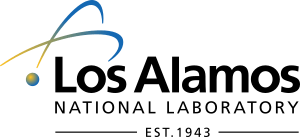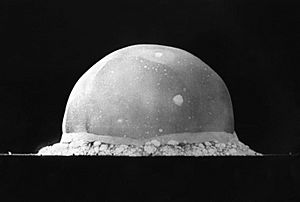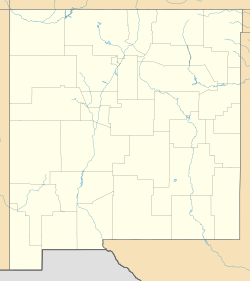Los Alamos National Laboratory facts for kids
|
|
 |
|

Aerial view
|
|
| Established | 1943 |
|---|---|
| Budget | $2.92 billion |
|
Field of research
|
|
| Director | Thom Mason |
| Staff | 12,752 |
| Students | 1,613 |
| Location | Los Alamos, New Mexico, United States 35°52′32″N 106°19′27″W / 35.87556°N 106.32417°W |
| Affiliations |
|
|
Operating agency
|
Triad National Security LLC |
|
Los Alamos Scientific Laboratory
|
|
| Location | Central Ave., Los Alamos, New Mexico |
| Area | 22,200 acres (9,000 ha) |
| Built | 1943 |
| Architectural style | Bungalow/Craftsman, Modern Movement, Ranch |
| NRHP reference No. | 66000893 |
| Significant dates | |
| Added to NRHP | October 15, 1966 |
| Designated NHLD | December 21, 1965 |
The Los Alamos National Laboratory (often called Los Alamos or LANL) is a special science lab in the United States. It was first created during World War II to help design nuclear weapons as part of the secret Manhattan Project. You can find it northwest of Santa Fe, New Mexico, in the southwestern United States.
Los Alamos was chosen in 1942 as the top-secret place for designing the atomic bomb. It officially started in 1943, managed by the University of California. Back then, it was known as Project Y. It was the main center for weapon design and planning. Other labs, like Oak Ridge National Laboratory and the Hanford Site, focused on making the fuel for the bombs. Los Alamos brought together many famous scientists, including several Nobel Prize winners.
After World War II, the lab's existence became public. In 1952, another design lab, the Lawrence Livermore National Laboratory (LLNL), was started. Since then, these two labs have worked on many different bomb designs. After the Cold War ended, both labs started focusing more on peaceful science. Today, Los Alamos is one of the biggest science and technology places in the world. It does research in many areas, like national security, space exploration, nuclear fusion, renewable energy, medicine, and supercomputing.
Today, Triad National Security, LLC manages and runs LANL.
Contents
History of Los Alamos Lab
Building the First Atomic Bombs
The Los Alamos Laboratory was created during World War II. It was a secret place to bring together all the scientific work for the Manhattan Project. This project was the effort by the Allied countries to build the first nuclear weapons. By September 1942, it was clear that scientists needed one main lab to work on these weapons.
General Leslie Groves wanted a secret lab in a faraway place for safety. He also wanted to keep the scientists away from other people. The lab needed to be at least 200 miles from any country borders and west of the Mississippi River. J. Robert Oppenheimer, who became the lab's first director, suggested the Los Alamos Ranch School in New Mexico. General Groves liked the spot as soon as he saw it.
During the Manhattan Project, thousands of people worked at Los Alamos. Many were Nobel Prize-winning scientists. The lab's location was a complete secret. Its only mailing address was a post office box in Santa Fe. The University of California managed the lab, and this relationship continued long after the war.

The lab's work led to the creation of several atomic devices. One was used in the first nuclear test, called "Trinity". This test happened near Alamogordo, New Mexico, on July 16, 1945. The other two devices were weapons, "Little Boy" and "Fat Man". These were used in the attacks on Hiroshima and Nagasaki, Japan.
After World War II
After the war, Oppenheimer left his role as director. Norris Bradbury took over. His job was to make the atomic bombs easier to build and use. Many of the first scientists left the lab. Some even spoke out against making more nuclear weapons.
The lab's name officially changed to Los Alamos Scientific Laboratory in 1947. In 1981, it officially became a National Laboratory.
Since the 1940s, Los Alamos has helped develop the hydrogen bomb and other types of nuclear weapons. In 1952, the Lawrence Livermore National Laboratory was created. It was meant to be a "competitor" to Los Alamos. The idea was that two labs designing nuclear weapons would lead to new ideas. Los Alamos and Livermore became the main secret labs for designing all of the country's nuclear weapons. They also did basic science research, developed particle accelerators, and studied nuclear fusion. Many nuclear tests happened in the Marshall Islands and at the Nevada Test Site.
Some safety incidents have happened at LANL. Buildings connected to the Manhattan Project at Los Alamos were named a National Historic Landmark in 1965.
Modern Research and Focus
After the Cold War ended, both Los Alamos and Livermore labs started doing more diverse scientific research. This was because less work was needed for new nuclear weapons. The lab now focuses more on peaceful science and technology. Los Alamos' nuclear work today mainly involves computer simulations and making sure existing nuclear weapons are safe. The Dual-Axis Radiographic Hydrodynamic Test Facility helps them do complex simulations without full explosions.
The lab also helped create early flow cytometry technology. This technology helps scientists study cells. In the 1950s, researcher Mack Fulwyler developed a way to sort red blood cells. In 1969, Los Alamos reported the first device that could accurately measure the number and size of cells using light.
As of 2017, the lab was working on cheaper, cleaner biofuels. They also worked to improve our understanding of renewable energy.
The lab also focuses on national security and defense that does not involve nuclear weapons. This includes preventing outbreaks of deadly diseases. They improve tools for finding diseases and check how well the United States' vaccines are given out. They also developed the ASPECT airplane, which can find biological threats from the sky.
Medical Discoveries
In 2008, scientists at Los Alamos were working on a safer and more accurate test for breast cancer. This new method, called ultrasound-computed tomography (ultrasound CT), uses sound waves to find small tumors that regular mammograms might miss.
The lab has also worked hard on humanitarian causes through its medical research. In 2010, scientist Bette Korber and her team were testing three vaccines for the Human Immunodeficiency Virus. These vaccines could help fight the AIDS virus.
Challenges and Changes
The laboratory has faced some challenges over the years. In 1999, a scientist was accused of improperly handling secret information. Later, two computer hard drives with secret data went missing but were found behind a copier. In 2000, a large forest fire, the Cerro Grande Fire, damaged some buildings and forced the lab to close for two weeks. In 2003, the lab's director and deputy director resigned after being accused of wrongly firing two people who reported problems at the lab.
In 2004, some hard drives were thought to be missing. The director, Peter Nanos, temporarily shut down parts of the lab. He said that security rules were not being followed. However, a report in 2005 found that the "missing" drives were just a mistake in the inventory system. The report said no secret information was lost. This event led to more distrust of the lab's management. In May 2005, Nanos stepped down as director.
In 2011, there was a safety incident involving plutonium. This led to a plutonium facility being shut down. The lab also faced a budget cut in 2014 due to an accident at the Waste Isolation Pilot Plant. In 2017, there was another issue with plutonium storage that could have caused a safety problem.
What Los Alamos Does Today
Los Alamos National Laboratory's main goal is to solve national security problems using excellent science. The lab's plans focus on nuclear security, defense, emergency response, stopping the spread of nuclear weapons, fighting terrorism, and managing the environment. This work fits with the goals of the Department of Energy (DOE) and other government groups.
Los Alamos is a very important lab in the DOE system. It works on all parts of the DOE's mission: national security, science, energy, and environmental management. The lab also works for the Department of Defense (DoD) and the Department of Homeland Security (DHS).
The lab's many science activities are divided into four main areas:
- Information, Science, and Technology: This area uses new ideas in math and powerful computers to make scientific predictions better.
- Materials for the Future: This area tries to make materials better for national security by understanding how they work and how to control them.
- Nuclear and Particle Futures: This area combines nuclear experiments, theories, and computer models to understand and control nuclear events.
- Science of Signatures: This area uses science and technology to solve tough problems in global security, nuclear defense, energy, and health.
Los Alamos works with other government groups, universities, and companies. They combine science and technology to help with important national security goals. To help with this, Los Alamos has three main facilities that other scientists can use:
- The Center for Integrated Nanotechnologies (CINT): CINT is a special facility that helps scientists study and build very tiny materials (nanomaterials).
- Los Alamos Neutron Science Center (LANSCE): LANSCE has one of the world's most powerful particle accelerators. It gives scientists strong sources of neutrons for research in both civilian and national security areas.
- The National High Magnetic Field Laboratory (NHMFL), Pulsed Field Facility: This facility at Los Alamos is one of three parts of the NHMFL. It lets scientists do research using very strong, pulsed magnetic fields.
As of 2017, Los Alamos National Laboratory was using data and algorithms to help protect public health. They were tracking the spread of infectious diseases. Scientists were using health data, Google searches, Wikipedia, and even tweets to predict epidemics. For example, they used data from Brazil to model the Zika virus before the 2016 Summer Olympics.
How the Lab is Managed
The Los Alamos property covers 43 square miles. It has many areas where waste has been stored. The lab has also helped manage waste at other sites across the U.S.
Changes in Management
To make the lab run better, the Department of Energy decided in 2003 to let other companies bid to manage the lab. The University of California had managed the lab for a long time. The University of California teamed up with companies like Bechtel Corporation to form a new company called Los Alamos National Security, LLC (LANS). This group competed against another team led by the University of Texas System. In December 2005, LANS won the contract to manage the lab for the next seven years.
On June 1, 2006, the University of California stopped being directly involved in running Los Alamos National Laboratory. LANS took over management on October 1, 2007. Most of the lab's employees continued to work for LANS. The University of California no longer directly controls the lab's daily operations.
On June 8, 2018, a new group called Triad National Security, LLC took over managing the lab. This group is a partnership between Battelle Memorial Institute, the University of California, and Texas A&M University.
Safety and Operations
In August 2011, a safety incident happened with plutonium. After this, many safety staff left. Because of safety concerns, the Plutonium Facility PF-4 was shut down in 2013 and remained closed for several years.
In August 2017, plutonium metal was stored improperly. This could have caused a serious safety problem.
Other Lab Activities
With help from the National Science Foundation, LANL runs one of the three National High Magnetic Field Laboratories. The other two are in Florida.
Los Alamos National Laboratory is also a partner in the Joint Genome Institute (JGI) in California. JGI was started in 1997 to bring together experts in genome mapping, DNA sequencing, and information science from several labs.
The Integrated Computing Network (ICN) at LANL connects many powerful supercomputers. IBM Roadrunner, which was part of this network, was the first supercomputer to reach very high speeds (petaflop speeds).
Until 1999, Los Alamos National Laboratory hosted the arXiv e-print archive. This is a place where scientists can share their research papers online. Now, Cornell University runs it.
The coreboot project, which helps computers start up, was first developed at LANL.
In recent years, the lab has started a big research program in systems biology modeling, known as q-bio.
LANL also publishes several science magazines and journals, like National Security Science and Actinide Research Quarterly.
Lab Facts and Figures
LANL is the biggest organization in northern New Mexico and the largest employer. It has about 8,762 direct employees, plus contractors, students, and researchers. About one-third of the lab's scientists are physicists. Others are engineers, chemists, materials scientists, and experts in mathematics, computational science, biology, and geoscience. Scientists and students from all over the world visit Los Alamos to work on projects. The lab also works with universities and companies on research. Its yearly budget is about US$2.2 billion.
Directors of Los Alamos Lab
- J. Robert Oppenheimer (1943–1945)
- Norris Bradbury (1945–1970)
- Harold Agnew (1970–1979)
- Donald Kerr (1979–1986)
- Siegfried S. Hecker (1986–1997)
- John C. Browne (1997–2003)
- George Peter Nanos (2003–2005)
- Robert W. Kuckuck (2005–2006)
- Michael R. Anastasio (2006–2011)
- Charles F. McMillan (2011–2017)
- Terry Wallace (2018)
- Thomas Mason (2018–present)
Notable Scientists Who Worked Here
- Stirling Colgate (1925–2013)
- Emily Willbanks (1930–2007)
- John Gosse
See also
 In Spanish: Laboratorio Nacional de Los Álamos para niños
In Spanish: Laboratorio Nacional de Los Álamos para niños


